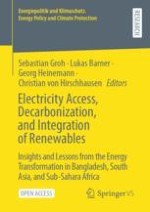This Open-Access-Book covers different aspects of the low-carbon energy transformation in a unique manner, with a particular focus on two regions, South Asia and Sub-Saharan Africa. The first part of the book provides useful insights on changes and reforms in the energy sector of Bangladesh, while the second part illustrates the low-carbon energy transformation in South Asia and the third part covers lessons from Sub-Saharan Africa. In all of these regions, the energy sector is undergoing major changes, driven by the four D’s: Decarbonization, decentralization, digitization, and democratization. Major overhauls are taking place at all levels: The country level, where energy mixes are rapidly changing, the corporate level, where large state-owned and private companies are challenged and new actors are emerging, and the local level, where technical and regulatory change has made citizen engagement and community power an option to replace or at least complement centralized supply structures.
